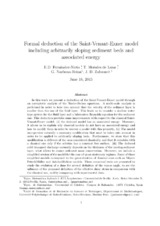Formal deduction of the Saint-Venant-Exner model including arbitrarily sloping sediment beds and associated energy
Autor
Fernández-Nieto, E.D.
Morales de Luna, Tomás
Narbona-Reina, G.
Zabsonré, J.D.
Fecha
2017-04-04Materia
Saint-Venant-Exner modelNavier-Stokes equations
METS:
Mostrar el registro METSPREMIS:
Mostrar el registro PREMISMetadatos
Mostrar el registro completo del ítemResumen
In this work we present a deduction of the Saint-Venant-Exner model through
an asymptotic analysis of the Navier-Stokes equations. A multi-scale analysis is
performed in order to take into account that the velocity of the sediment layer is
smaller than the one of the
uid layer. This leads us to consider a shallow water
type system for the
uid layer and a lubrication Reynolds equation for the sediment
one. This deduction provides some improvements with respect to the classical Saint-
Venant-Exner model: (i) the deduced model has an associated energy. Moreover,
it allows us to explain why classical models do not have an associated energy and
how to modify them in order to recover a model with this property. (ii) The model
incorporates naturally a necessary modi cation that must be taken into account in
order to be applied to arbitrarily sloping beds. Furthermore, we show that this
modi cation is di erent of the ones considered classically, and that it coincides with
a classical one only if the solution has a constant free surface. (iii) The deduced
solid transport discharge naturally depends on the thickness of the moving sediment
layer, what allows to ensure sediment mass conservation. Moreover, we include a
simpli ed version of the model for the case of quasi-stationary regimes. Some of these
simpli ed models correspond to the generalization of classical ones such as Meyer-
Peter&M uller and Ashida-Michiue models. Three numerical tests are presented to
study the evolution of a dune for several de nition of the repose angle, to see the
in
uence of the proposed de nition of the e ective shear stress in comparison with
the classical one, and by comparing with experimental data.

